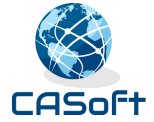Years ago in the manufacturing industry, ERP solutions federated all the information in one place, in order to optimise processes and costs.
The coming generation of tools for Software Engineering Project Management are on their way to doing just that. There is still a long way to go, but the trend is there.
Team Foundation Server (TFS) is a Microsoft offering for source control, data collection, reporting, and project tracking, and is intended for collaborative software development projects.
It is one of the best tools out there today for managing and federating the information of Software Engineering projects and for Project Management.
When creating a project within TFS, there are 2 project templates to choose from:
–MSF Agile provides Work items and Processes that support Agile programming approach
–MSF CMMI is based on MSF Agile, and it stretches the Agile approach to comply with CMMI Maturity level 3. It is 150% larger than MSF Agile, for example MSF Agile has 25 work product artifacts, MSF CMMI has 59.
In TFS, everything in managed as a Work Item. The Work Items available, when using MSF Agile, are Scenario, Task, Bug, Risk and Quality of Service Requirement.
It is however possible and easy to add other work items, such as Test Case and Requirement.
In their presentations about TFS, Microsoft recommend the following links organisation:
 Queries can be created to research Work Items.
Queries can be created to research Work Items.
Reports can be developed and run to provide all sorts of information and calculated measures about Work Items and projects, such as Bugs rate and Remaining work for example.
SharePoint Web Access is the Web Interface that provides access to all the TFS functionality through a web-based application. Timesheets can be entered using SharePoint Web Access.
Customers can be given access to the information about their projects through SharePoint Web Access, and can monitor their progress. This can decrease significantly the need for reporting.
The TFS solution also provides a Portal as a single point of storage for documents, which can be organised by project for example. It also has a wiki-like feature.
It possible to export the information in TFS into EXCEL spreadsheets, which can be updated / refreshed at the click of a button. This information can be instanciated in tables or in pivot-tables. It is also possible to modify the information in the spreadsheet and upload it back in TFS. Some teams choose to upload their requirements this way.
They are also add-ins that allow integration with third party products, such as Caliber and Test Director.
The Power Tools, which must be downloaded and installed separately, allow to create and edit processes and work items, and much more.
The 2010 edition of TFS will provide the following functionality:
- Architecture Explorer provide a graphical visualisation of the code
- 7 UML diagrams will be supported (the Microsoft Diagrams won’t be supported, though Microsoft is working on their Oslo model-driven development strategy)
- Tools for test cases management
- Test Impact View – run tests impacted by a code change only
- Enhanced Vision Control – gated check-in, branch visualisation and build worklfow
What do you like or dislike about TFS? leave comments below.
 CASoft Blog
CASoft Blog









